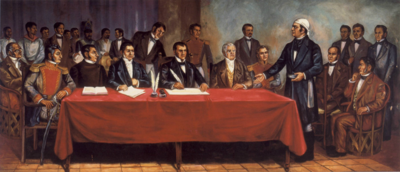Chilpancingo Congress

The Congress of Chilpancingo (also: Congress of Anáhuac ) met from September to November 1813 in the city of Chilpancingo in what is now the Mexican state of Guerrero . The program of Mexico's independence movement, which had existed since 1810, was first set out in writing in a declaration .
prehistory
The priest and independence fighter Miguel Hidalgo y Costilla had already postulated on September 16, 1810 in his later famous 'Call of Dolores' ( Grito de Dolores ) the freedom and independence of Mexico from the Napoleonic occupied motherland Spain . The exact wording of the grito is unknown today. After armed conflict, Hidalgo and his colleague Ignacio Allende were captured the following year and executed in Chihuahua in the summer of 1811 . However, the struggle continued - its leader on the side of the insurgents ( Insurgentes ) was the lawyer Ignacio López Rayón , who had some minor military successes as general of the army of the insurgents.
congress
López Rayón was a founding member of the Chilpancingo Congress, but the Congress was entirely under the - not undisputed - authority of José María Morelos . In a declaration of September 14, 1813, the so-called “feelings of the people” ( Sentimientos de la Nación ) were formulated and recorded in 23 articles ; the most important are:
- 1. Mexico is free and independent from any other nation.
- 2. The Catholic religion should be the only one without tolerance for another.
- 5. Sovereignty comes from the people.
- 6. Based on the ideals of the French Revolution , state power is divided into legislative , executive and judicial branches .
- 11. The monarchical system is exchanged for a liberal one.
- 15. Slavery and the class system are abolished.
- 22. The taxes and duties of the Indians are abolished.
A day later, the congress decided to address José María Morelos as " Your Highness " ( Altezza serenissima ), but the latter refused; instead he sees himself as a “servant of the people” ( Siervo de la Nación ). He again proclaimed Mexico's independence on November 6, 1813, but was captured by Spanish forces two years later, taken to the capital and shot outside the city on December 22, 1815.
literature
- Stefan Rinke: Revolutions in Latin America Paths to Independence 1760–1830 . CH Beck, Munich 2010, ISBN 978-3-406-60142-2 , p. 150 ( preview in Google Book Search).
- Virginia Guedea: The Process of Mexican Independence . In The American Historical Review No. 105 (1), 2000, pp. 116-130.
- Josefina Zoraida Vazquez: The Mexican Declaration of Independence . In: The Journal of American History No. 85 (4), 1999, pp. 1362-1369.
Web links
- Congress of Chilpancingo - Info (English)